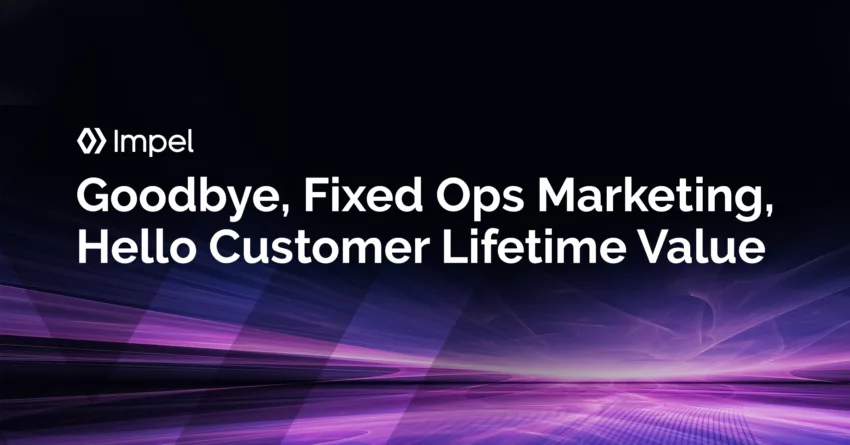
Why it’s time for dealerships to pivot away from traditional fixed ops marketing to an AI-powered customer lifecycle model that enables long-term revenue growth.
With car buyers increasingly cautious in the face of high-interest rates and reduced purchasing power, it’s never been more important for dealerships to rethink their fixed ops business and marketing model. Fortunately, there are compelling opportunities for sustainable revenue growth in optimizing the service drive.
According to the January 2023 report from Cox Automotive, service activity and revenue have both increased over the previous year as car owners wring more mileage from their current vehicles. Service demand is strong and will get stronger – and there is ample opportunity for dealers to capture more of it. And fixed ops revenue is much more resilient to a recessionary environment than variable ops.
The problem is that most dealerships have a capacity challenge: dealership staffing is leaner than ever. Service departments rarely have the capacity to handle incoming calls and manage their current customers, while also scaling follow-up to retain current customers while engaging in outreach to re-engage lost customers.
For many dealerships, the lion’s share of attention has long been on sales. However, to drive sustainable growth in an uncertain economy, it’s essential that dealerships leverage innovative technology to increase customer retention and maximize customer lifetime value (CLV). In this post, we’ll explore how AI can boost customer lifecycle management and grow revenue.
Boost operational productivity with AI-powered customer analytics
Effective communications depend on personalization and relevance, and your DMS database contains a wealth of information that supports both. Examples include vehicle sales history, service history and customer behavioral information.
The challenge is that DMS databases typically contain tens of thousands of records, or even hundreds of thousands in the case of large franchise dealerships. It’s simply impossible for a service team to manually mine the DMS to see which customers are due for service. While conventional DMS solutions can partially address these challenges, they’re often not smart enough to identify customers by behavioral and service history, service or repair opportunity, or status (for example, lapsed customers, or customers who may be receptive to trade-in or a car buying offer).
AI-powered data mining and advanced analytics can identify patterns and trends in DMS data that would be impossible for staff to detect manually in a timely manner. By translating that data into insights at machine speed, service teams can instantly get a big-picture view of their customers and the service history of their vehicles. The stage is the set for the dealer to optimize their service offerings with personalized and timely communications.
Generate more service appointments with personalized communications
It’s well-documented that attention spans are short in the digital era. However, what consumers are really short on is patience. Customers have no patience for generic mass communications that pay no heed to their specific needs and circumstances.
Mining DMS data for insights is just the first step in increasing revenue within your existing customer base. The next step is actual communications, which involve sending emails or SMS notifications to the right people at the right time. Once again, the challenge is scale, and most dealership service teams simply don’t have the capacity to compose hundreds of emails every week and engage in tons of phone calls to encourage customers to book their service appointments.
The more robust AI solutions that leverage machine learning, large-language models (LLM), and generative AI capabilities can mine databases, analyze records, extract insights, and use predictive analytics to automate personalized and relevant communications at unlimited scale. This combination of factors can help dealers maximize customer lifetime value (CLV) by reaching out to customers at the right time and addressing the right need given their demographics, past behavior, and their stage in the ownership lifecycle.
Maximize customer lifetime value with AI-augmented lifecycle management
Traditional fixed ops marketing is purely about getting customers to have their cars serviced at the dealership of purchase. While that remains a fundamental goal, it doesn’t capture the full customer lifecycle opportunity. In fact, there are many other initiatives that can help drive customer loyalty throughout the ownership experience, such as white-glove check-ins for new customers, state inspections, declined service communications, and expiring warranty, missed intervals, pre-paid services, trade-in cycles, and value-added protection services. Other options include abandoned customer re-engagement and letting customers know about vehicle safety recalls, which give the dealership an opportunity to present additional service opportunities
For any auto retailer, the perfect customer is one who services their vehicle solely at the dealership up until the time of their next unit purchase, where the ownership lifecycle starts anew. Sending service reminders helps with opportunistic appointments, but AI-powered communications at every touchpoint of ownership secures long-term service retention and CLV.
Post-service follow-up also presents an opportunity for encouraging vehicle owners to trade in their old vehicles with compelling offers and incentives, which benefits the customer and secures a healthy used car inventory for the dealer. This tactic can be extremely effective since it specifically engages customers whose cars are nearing the end of their loan payments and will be in the market for a new car.
The benefits of deploying generative generative AI in customer retention strategies at scale are enormous. By maximizing found revenue across the entire customer lifecycle, dealerships can not only protect themselves from a poor economy; they can thrive in a recession when the average age of vehicles on the road inevitably increases. The secret to success lies in using automation to free up staff to focus on effectively handling inbound calls and providing customers at the dealership with a high-touch, white glove experience. That powerful combination will result in greater customer loyalty than ever for dealerships that embrace AI.
AI-powered automation is transforming the service experience and helping dealers optimize the vehicle ownership lifecycle. Learn more by downloading our Fixed Ops white paper.

